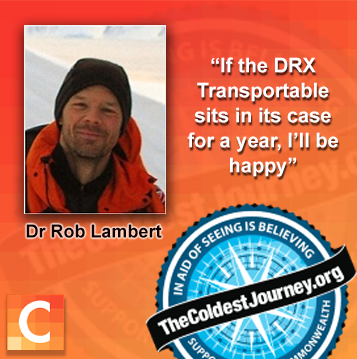The Coldest Journey: Q&A with Dr. Rob Lambert, Expedition Team Doctor
Reading Time: 3 minutes read
We managed to catch up with Dr. Rob Lambert, expedition team doctor, before he left the UK to fly to Cape Town and join the rest of the Coldest Journey team. We were able to get a little more background on the journey he faces and why the DRX Transportable is going with them.
Rob, tell us a bit about yourself and how you came to be involved in The Coldest Journey.
I trained as a doctor in the UK, focusing on A&E (accident and emergency) and then spent the last year in Antarctica with the British Antarctica Survey. When I heard about the plans last year for The Coldest Journey expedition I applied to join, and here we are now. I’ll be involved in the project until February 2014, or thereabouts, and then I’ll be heading back to the NHS to look for a job!
I’m the only trained medic on the team, but everyone is first aid trained and comes with masses of experience in this field. I’ll also have various medical consultants on call should the need arise. In conditions such as those we’re facing, it’s the minor things that can turn into major traumas. Blisters for example, in normal circumstances, wouldn’t be too much to worry about but can be debilitating on a journey such as this.
You were responsible for selecting the DRX Transportable. We spoke recently to Wendy Tiller in the UK and understand that Sir Ranulph Fiennes himself made the call to find out more (she thought it was a prank call!) Tell us how you found the system and how you plan on using it.
We’re a six-person team traveling completely self-sufficiently, so we need to have all of the medical equipment we are possibly going to require along with us. We needed a digital X-ray system to take with us on the expedition and I looked closely at all of the systems available before settling on Carestream. Ran (Sir Ranulph) gets involved with all of the sponsors so once I had flagged up to him that the DRX Transportable could do everything we needed, he put in the call. Since then I’ve worked very closely with the UK sales team, who have put together a package that fulfills all of our needs.
The best-case scenario is that we never have to use the DRX. It’s a back-up piece of equipment for a worst-case scenario, and if it sits in its case for a year, I’ll be happy.
Huskies have been banned from Antarctica since the Madrid Protocol of 1991 – to prevent the introduction of disease to indigenous species – so the team has to rely on mechanical pulling power in the shape of bulldozers that will pull the cabooses, and the porta-cabin style living quarters that house all of the food, fuel, equipment and living quarters for the team.
The equipment will be tested before we reach Antarctica, will be placed in one of these cabooses, and will be kept in decent conditions. From a medical perspective the conditions are tricky, space is cramped and working in the medical equivalent of a shoe-box is going to be challenging to say the least.
Sir Ranulph Fiennes, accompanied by another member, will lead the team at all times, skiing out front using ground-penetrating radar to avoid crevasses. The team of six will always be within a relatively short distance of the land-train. This means that any medical procedures can be carried out immediately, more or less.
What are your expectations of the challenges ahead?
It’s so difficult to project ahead. Especially if we’re successful, we’ll be the very first team to have achieved this crossing, so there’s no benchmark.
Dealing with the weather and the extreme cold are the obvious challenges and I’m sure that will present lots of issues. There’s always the potential for something really serious to happen, which is why we’re fully equipped medically, including the DRX Transportable, and we have a really experienced team.
But the biggest unknown lies in the emotional challenge, the team dynamic and how six people living in confined quarters will get on. That, ultimately, is what will determine the success or failure of this trip.
Right now it will be a relief to get on with business, all of the planning, and the months and months of work have all been working to get us to this point. Now it’s time to start the engines and start putting one foot in front of the other.
The Twitter accounts for The Coldest Journey and Carestream will be posting updates throughout the team’s journey. You can follow the organizations at @coldestjourney and @Carestream. You can also follow The Coldest Journey’s updates on Facebook. We wish Sir Ranulph, Dr. Lambert, and the team a safe and successful journey across Antarctica.

